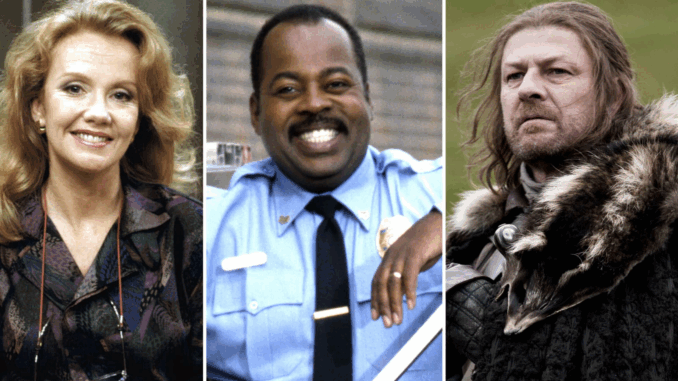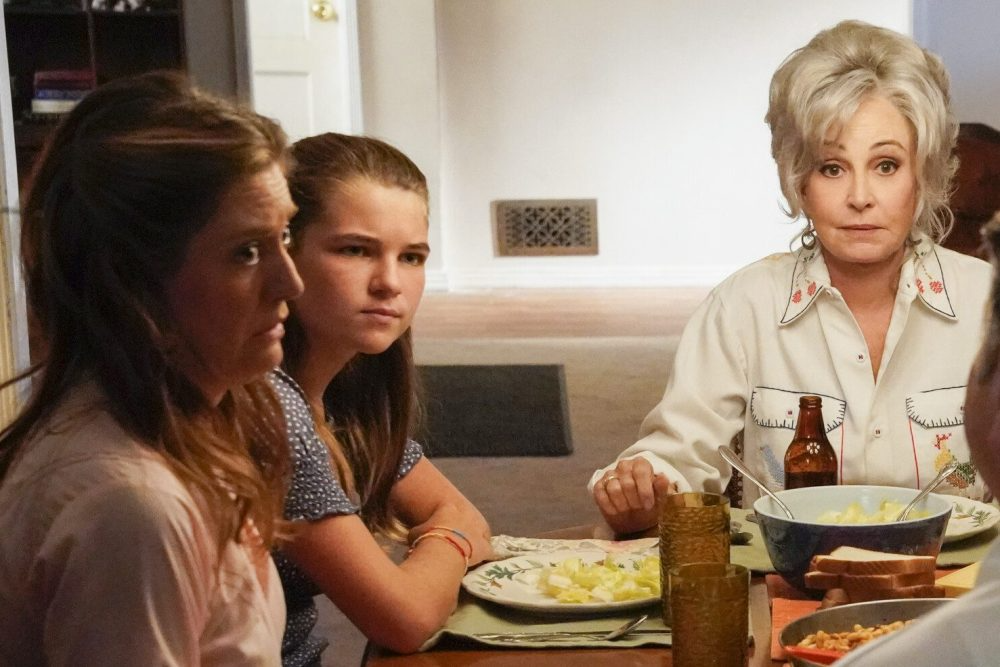
One of the pleasures of television is watching how it changes over several seasons. Strange as it might seem, there are a remarkable number of series in which the original star members of the cast who are meant to anchor an entire show start to withdraw into the background, or at the very least tend to become more part of an ensemble than stars in their own right. Television, even more than film, has the remarkable ability to shift and change as it goes on, giving characters the chance to grow, develop, and change, just as do people in the real world.
‘Will & Grace’
Despite its title, Will & Grace ended up being very much an ensemble piece, thanks in large part to the hilarious performances from Sean Hayes and Megan Mullally. Their characters, Jack and Karen, became as much a part of the show’s appeal as Will and Grace, particularly in the later seasons. The fact that the series leaned very heavily on its guest stars in its last few seasons also ensured that the title characters started to become less of a focus, which was both a blessing and a curse for the series as a whole.
‘The Office’
Though The Office was always an ensemble show, in the early seasons, it’s clear that delightfully and awkwardly strange Michael was the show’s center of gravity. Fortunately for both the show and its fans, this began to change the longer it went on, with other characters — Jim and Pam, Dwight, and so on — taking up more narrative time. Given that Michael ended up leaving the show before it ended, this was a very good thing, and the series’ characters remain a part of its enduring appeal.
‘Brooklyn Nine-Nine’
In true sitcom form, Brooklyn Nine-Nine took a season or two to really find its feet. What began as a show that was primarily focused on the antics of Jake Peralta (played by Andy Samberg) quickly became a much more emotionally mature show that wasn’t afraid to draw attention to the inner lives of its other characters. Characters such as Rosa, Captain Holt, and Charles ended up at the center of their own arcs, and this helped contribute to the show’s enduring popularity.
‘Parks and Recreation’
The first two seasons of Parks and Recreation are not notable for how much they focus on Amy Poehler’s Leslie Knope and for being tonally different from the rest of the series. Like many other shows, the series found its footing in the later seasons, and part of this involved diving more deeply into the other characters. While Leslie never entirely faded from the show’s consciousness, it became clear that she was part of a team rather than a lone wolf, and the series was better for it.
‘Barney Miller’
Like many other sitcoms of its era, Barney Miller bore the name of its title character. At first, it certainly seemed as if it was going to focus primarily on him, but, as time went on, it broadened its scope, giving the various other members of the police station their time to shine. This ended up being a good thing since the series boasted some truly remarkable comedic talents, including the likes of Abe Vigoda, Ron Glass, and Steve Landesberg.
The Mary Tyler Moore Show was a bit of a trailblazer, thanks in large part to the title character, who was an unapologetic working woman. While she was always a key character in the show, as it went on, it became much more of an ensemble comedy, focusing more and more on the various characters with whom she interacted at work. As a result, it became one of the most notable workplace sitcoms of the 1970s and a bastion of feminist representation in TV.
‘Game of Thrones’
When the series Game of Thrones started, it was very much focused on the friendship of Robert and Ned, the King and his Hand. The first season showed that there were many other stories, and while Ned remained central, he was gradually overshadowed by many of the other characters, including his own children. This ultimately proved to be just as well, as he ended up being executed, his death proving an event that would shake the Seven Kingdoms to their foundations. It’s not every show that would dare to kill off its moral center and main character, but Game of Thrones did so and managed to secure its place in TV history.
‘Saved by the Bell’
Before there was Saved by the Bell, there was Good Morning, Miss Bliss. Though featuring some of the same characters appearing in the subsequent series, it was much more focused on Hayley Mills’ Miss Bliss, the kindly teacher. After its first season, Mills would be written out, leaving the show to focus much more on the students and their various foibles. It was a shame, though, since Mills was as charming as ever, but the series would nevertheless achieve remarkable success as Saved by the Bell.
‘Spartacus’
As its title implies, the Starz series Spartacus focuses, at least for much of its first season, on the titular gladiator and his efforts to achieve freedom from Rome. Due in part to star Andy Whitfield’s illness, the show went back in time for a second season, before once again rejoining Spartacus in the third and fourth. As the show went on, it expanded its scope to further elaborate on the lives, desires, and foibles of its other characters — Roman and gladiator alike — which gave it more depth and, ultimately, more resonance.
‘Young Sheldon’

As its title implies, Young Sheldon focuses on the title character when he was a child. Though he remains a key part of the show, it fortunately manages to become an ensemble the further it makes it into its run. This is hardly surprising, however, given the remarkably talented cast that it brings to bear, including Zoe Perry and Annie Potts. While it may never quite hit quite the same level as The Big Bang Theory, it still manages to be a charming sitcom on its own, entirely due to its cast.
‘Alice’
Alice started by focusing on Linda Lavin’s character of the same name (which makes sense since the series was based on the Martin Scorsese film Alice Doesn’t Live Here Anymore). Though Alice would remain a key part of the show, she became just one part of an ensemble cast. Understandably, as the series went on, it started to focus more and more on the various other employees of the diner where Alice works. It ended up being a remarkably successful series, running for numerous seasons and producing a spinoff, Flo.
‘The Hogan Family’
The sitcom The Hogan Family actually began life as Valerie, starring Valerie Harper. However, she was fired between the second and third seasons, which resulted in her character being killed off and ultimately replaced by Sandy Duncan. Some shows would have just thrown in the towel after the firing of a major star, but in this case, the show actually became stronger without its original main character. It would end up running for a total of six seasons, ultimately producing over one hundred episodes.
‘Once Upon a Time’
The central premise of the first season of ABC’s Once Upon a Time is actually quite brilliant, focusing as it does on the various classic Disney characters who have been be-spelled so that they lose their memories and their magic and have to live in the real world. Originally, several characters, including Emma, Snow White, Prince Charming, Regina, and Henry, were the focus. As the show went on, though, they gradually became less of a center as the show sprawled every which way. The show eventually lost its way, but for a while, it was a brilliant piece of fantasy storytelling.
‘Glee’
The early seasons of Glee were very much focused on two principal characters: Kurt and Rachel. In one way or another, the fortunes of the various other characters almost always revolve around what’s going on with the two of them. After the second season, however, the show began to broaden its focus, drawing in a number of other characters and giving them their own time to shine. Not every storyline and character really landed, but the series does deserve credit for its willingness to take chances.
‘The Book of Boba Fett’
Despite its title, The Book of Boba Fett is only partially about its title character, the infamous bounty hunter from Star Wars. However, starting about halfway through the season, The Mandalorian’s Din Djarin becomes an ever more prominent part of the show. While it’s always a pleasure to see this particular character, it’s still rather distracting for him to become such a prominent part of a show that isn’t technically focused on him. It’s doubly unfortunate, given the powerful performance that Temuera Morrison gives as Fett.
‘MASH’
In its earlier seasons, MASH focused on the adventures of Alan Alda’s Hawkeye Pierce and Wayne Rogers’ Trapper John. However, as the seasons went on, the show became much more of an ensemble piece. This was to its own benefit, as it allowed its very talented cast to show off their acting prowess (and, in Alda’s case, also his directorial abilities). Thanks in part to this expanded focus, the series became a much stronger show, and it more than deserves its reputation for being one of the best shows of the 20th century.
‘Family Matters’
Given just how prominent Steve Urkel became in Family Matters, it’s rather jarring to find out that he wasn’t even supposed to be the focus of the show. At first, it was primarily supposed to focus on characters Herriette and Carl and their family. Steve proved to be an enormous hit, and this drastically changed the way the show worked. It proved to be a good change, and Steve’s popularity as the annoying yet somehow charming character helped ensure that the show ran for nine seasons.
‘Orange is the New Black’
When Orange is the New Black began, Piper Chapman was quite clearly the main character. As the series goes on, she becomes very much part of an ensemble series, with many other characters coming into their own and taking just as much control of the narrative. While a less deft series might have fumbled this particular change in priorities, Orange is the New Black featured such strong writing and such potent performers that it became a better show due to its expanded focus.
‘The Wheel of Time’
Based on the book series by Robert Jordan, The Wheel of Time began by focusing primarily on the various young people from Emond’s Field and the Aes Sedai Moiraine. Each season, however, has brought more characters into the mix, including the sinister Forsaken Lanfear and the cunning Aes Sedai Elaida. The original characters are still there, of course, and they still have their own stories, but there’s no doubt that they, particularly Moiraine, are much less a focus than they were in the beginning. This is quite in keeping with Jordan’s work, which was always notable for its sprawling cast of characters.
‘The Boys’
The Boys, the Amazon adaptation of the graphic novel series of the same name, was very much Hughie’s story in the beginning. To some extent, that is still true, but the series has constantly expanded its scope and given more time and psychological exploration to several characters. This includes heroes and villains, and viewers have gained an increasing understanding of both figures like Billy Butcher and his nemesis, the deeply troubled Homelander. An increased attention to various other characters means that the show continues to expand its own dramatic potential.
